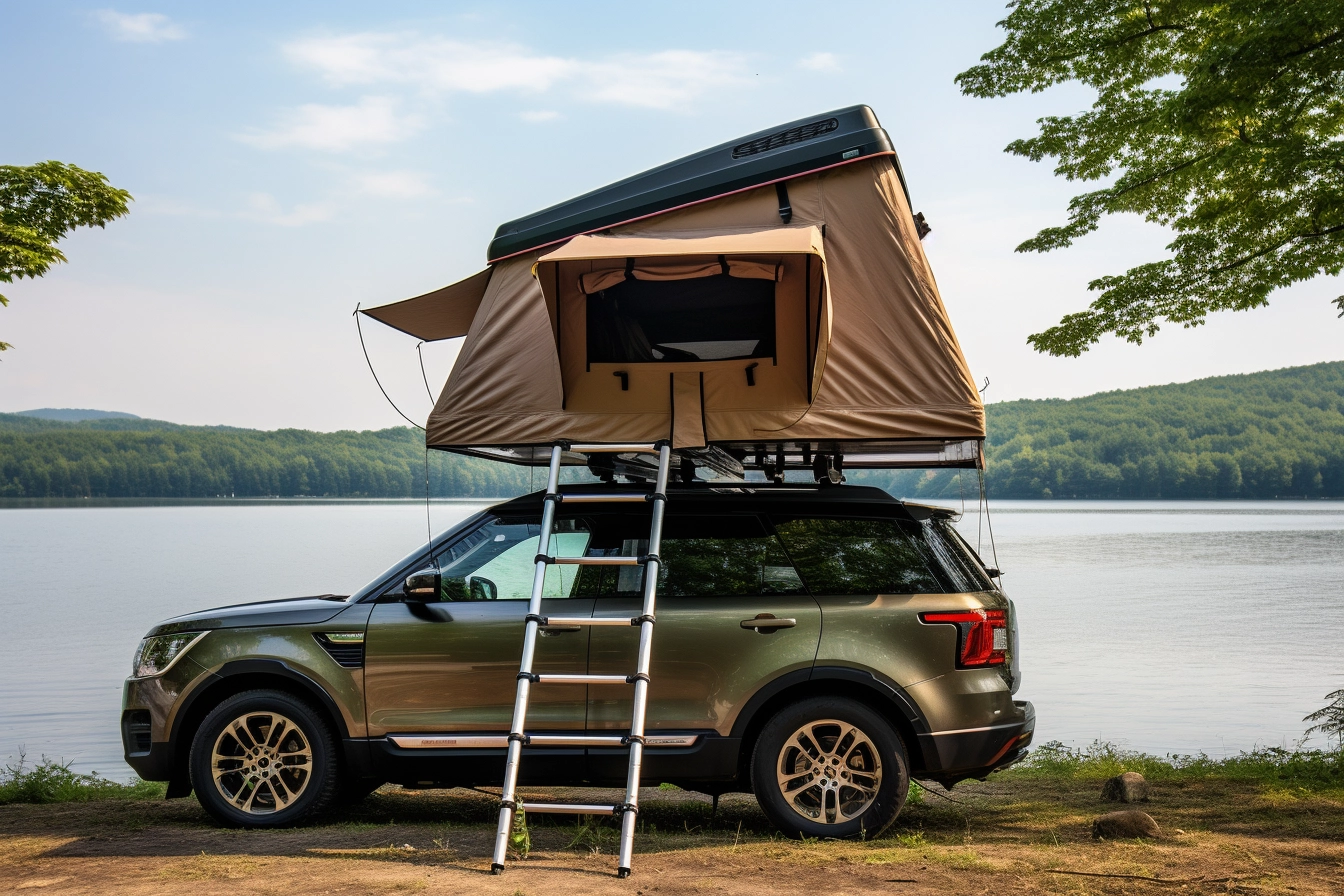UK's Best Roof Tents For Cars, Vans, Pickups, 4x4s
Roof tents are a popular choice among outdoor enthusiasts looking for a convenient and comfortable camping solution. Whether you have a car, van, pickup, or 4×4, a roof tent can transform your vehicle into instant accommodations. In this article, we will explore the top-quality roof tents available on the market, perfect for a brilliant British adventure.
What is A Roof tent?
A roof tent, also known as a rooftop tent or RTT, is a portable, foldable tent designed to be mounted on the roof of a vehicle. It provides a convenient and elevated sleeping space, allowing outdoor enthusiasts to transform their vehicles into cozy, mobile shelters.
Key Features:
- Easy Setup: Roof tents are celebrated for their quick and hassle-free setup. Most models can be unfolded and ready for use within minutes, eliminating the need for extensive tent pitching.
- Elevated Comfort: Elevated above the ground, these tents offer a unique camping experience. You’re shielded from uneven terrain, potential ground-dwelling creatures, and adverse weather conditions.
- Space Efficiency: Roof tents are space-efficient, leaving the vehicle’s interior available for other gear and necessities. This makes them an ideal choice for those who prefer a minimalist camping setup.
- Versatility: Whether you’re embarking on a weekend getaway or an extended road trip, roof tents are versatile companions. They are suitable for various vehicle types, including SUVs, trucks, and off-road vehicles.
Are Roof Tents Worth It?
- Mobility: With a roof tent, your camping spot can change every night. Explore new locations without the need to find flat ground for tent setup.
- Safety: Elevated sleeping reduces the risk of encounters with wildlife and provides an added layer of security, especially in remote camping areas.
- Adaptability: Roof tents are designed to withstand various weather conditions, providing a comfortable shelter in rain, wind, or shine.
Choosing the Right Roof Tent: Consider factors such as tent size, material durability, ease of setup, and additional features like built-in awnings or annexes when selecting a roof tent. It’s crucial to match the tent’s specifications with your specific needs and the type of outdoor adventures you envision.
In summary, a roof tent is a transformative camping accessory that brings comfort, convenience, and a touch of adventure to your outdoor experiences. Whether you’re a seasoned traveler or a weekend warrior, exploring the world from the vantage point of a roof tent opens up a new realm of possibilities.
What do I need to install a roof tent?
Embarking on the journey of installing a roof tent involves a bit of preparation and the right tools. Here’s a comprehensive guide on what you need to ensure a seamless installation process:
1. Roof Rack: The foundation of your roof tent setup is a sturdy roof rack. Ensure that your vehicle is equipped with a roof rack capable of supporting the weight of the tent and its occupants. Most roof tents are compatible with various roof rack systems, providing flexibility for different vehicle types.
2. Crossbars: Crossbars are essential components of the roof rack, providing the necessary support for the tent. Choose crossbars that are compatible with your vehicle’s make and model, and ensure they are securely attached to the roof rack.
3. Roof Tent: Of course, you’ll need the star of the show – the roof tent itself. Select a tent that suits your camping needs, taking into consideration factors such as size, material durability, and additional features like windows, ventilation, and annexes.
4. Mounting Hardware: Check the manufacturer’s recommendations for the specific mounting hardware required for your roof tent model. This typically includes bolts, nuts, and brackets designed to securely attach the tent to the roof rack. Ensure that all components are included in the kit before starting the installation.
5. Tools: A basic toolkit will come in handy for the installation process. This may include wrenches, screwdrivers, and other tools specified in the tent’s installation instructions. Having the right tools ensures a smooth and efficient setup.
6. Level Surface: Find a level and stable surface for the initial installation. This makes it easier to adjust the tent and ensures a comfortable sleeping experience. A flat parking space or driveway is an ideal location for the first setup.
7. Assistant: While it’s possible to install a roof tent solo, having an extra set of hands can make the process smoother, especially when lifting and positioning the tent onto the roof rack. Enlist a friend or family member to help with the installation.
8. Patience and Time: Installing a roof tent for the first time may take a bit of time, especially as you familiarize yourself with the process. Approach the installation with patience, carefully following the manufacturer’s instructions step by step.
By gathering these essentials and carefully following the installation guidelines provided by the tent manufacturer, you’ll be well on your way to creating a cozy elevated retreat for your outdoor adventures.
Choosing Between Hard Shell vs Soft Shell Roof Tents
Embarking on the rooftop camping adventure opens up the question: hard shell or soft shell roof tent? Each type comes with its own set of advantages and considerations. Let’s delve into a comparison to help you make an informed decision:
1. Setup and Ease of Use:
- Hard Shell:
- Pros: Hard shell tents typically boast a quicker setup process. With their pop-up design, they unfold effortlessly, and securing them into place is a breeze. This is especially advantageous for those who prefer a swift camping setup.
- Cons: While generally easier, hard shell tents might require a bit more effort in terms of securing latches and mechanisms compared to their soft shell counterparts.
- Soft Shell:
- Pros: Soft shell tents are known for their straightforward setup. They often utilize a simple unfolding or extending mechanism, making them accessible for campers of all experience levels.
- Cons: Depending on the model, some soft shell tents may take a bit more time to set up compared to hard shell tents.
2. Aerodynamics and Fuel Efficiency:
- Hard Shell:
- Pros: Hard shell tents are designed with aerodynamics in mind, which can contribute to better fuel efficiency. The sleek, streamlined profile minimizes wind resistance, making them ideal for long drives between camping destinations.
- Cons: The added weight and bulk of hard shell tents may impact overall vehicle weight, potentially influencing fuel efficiency to some extent.
- Soft Shell:
- Pros: Soft shell tents are generally lighter than their hard shell counterparts, contributing to improved fuel efficiency. Their fabric construction also minimizes wind resistance, making them suitable for extended road trips.
- Cons: While more aerodynamic than hard shell tents, they might not offer the same fuel efficiency benefits.
3. Durability and Weather Resistance:
- Hard Shell:
- Pros: Hard shell tents excel in durability. The rigid construction provides robust protection against the elements, including rain, wind, and snow. They are often equipped with hard-shell materials that can withstand harsh weather conditions.
- Cons: Some may argue that hard shell tents lack the breathability of soft shells, potentially leading to a warmer interior in hot climates.
- Soft Shell:
- Pros: Soft shell tents are known for their breathability, making them suitable for warm weather camping. Modern soft shell materials are also highly durable and resistant to the elements.
- Cons: While weather-resistant, they may not provide the same level of protection in extreme conditions as hard shell tents.
4. Interior Space and Comfort:
- Hard Shell:
- Pros: Hard shell tents often offer a more spacious and structured interior. They may come with additional features like built-in mattresses and storage compartments, enhancing overall comfort.
- Cons: The interior space can be limited to the size of the hard shell, potentially making them less suitable for larger groups.
- Soft Shell:
- Pros: Soft shell tents are flexible in terms of interior space. Their fabric walls allow for expanded interior room, and they are available in various sizes to accommodate different camping needs.
- Cons: The lack of a rigid structure might make them feel less structured and spacious than hard shell tents.
Conclusion:
Ultimately, the choice between a hard shell and soft shell roof tent depends on your specific camping preferences, vehicle type, and the conditions you expect to encounter. Whether you prioritize quick setup, durability, or interior space, both options provide a unique rooftop camping experience tailored to different adventure styles. Consider your priorities, weigh the pros and cons, and choose the rooftop refuge that aligns with your camping aspirations.
FAQs
What is a roof tent?
A roof tent, also known as a rooftop tent or RTT, is a portable tent that is mounted on the roof of a vehicle, providing an elevated and convenient sleeping space for outdoor adventures.
How do I install a roof tent on my vehicle?
Installing a roof tent involves securing it to a roof rack on your vehicle. The process varies depending on the tent model, but it generally includes attaching mounting hardware and ensuring a stable setup.
Are roof tents compatible with all types of vehicles?
Roof tents are designed to be compatible with various vehicle types, including SUVs, trucks, and off-road vehicles. It’s essential to check the specifications and weight capacity of both the tent and your vehicle.
Can I drive with a roof tent mounted on my vehicle?
Yes, you can drive with a roof tent in the closed position. However, it’s crucial to adhere to the manufacturer’s recommendations regarding speed limits and driving conditions. Opened tents are generally not suitable for driving.
How long does it take to set up a roof tent?
The setup time varies between tent models. Hard shell tents often have a quicker setup with their pop-up design, while soft shell tents may take a bit longer. On average, it can range from a few minutes to around 15-20 minutes.
Are roof tents suitable for all weather conditions?
Roof tents are designed to withstand various weather conditions, including rain and wind. However, the level of weather resistance depends on the specific tent model. It’s essential to check the manufacturer’s specifications and recommendations.
How many people can a roof tent accommodate?
The capacity of a roof tent varies depending on its size and design. Tents are available in different sizes to accommodate varying numbers of occupants, ranging from solo travelers to larger groups.
Can I use my existing roof rack for a roof tent, or do I need a special one?
In most cases, you can use your existing roof rack for a roof tent. However, it’s crucial to ensure that the roof rack is compatible with the tent’s weight and size specifications. Some tents may also require specific crossbars or mounting systems.
Are roof tents suitable for off-road adventures?
Yes, many roof tents are designed with off-road adventures in mind. They are built to withstand rough terrains and provide a comfortable sleeping space during outdoor expeditions.
Can I leave bedding inside the roof tent when it's closed?
It’s generally recommended to remove bedding and personal items when closing the roof tent to ensure a secure and proper closure. This prevents damage and ensures a smooth setup the next time you use it.
Do roof tents come with mattresses?
Many roof tents come with built-in mattresses for added comfort. However, the thickness and quality of the mattress can vary between models. It’s advisable to check the specifications of the specific tent you’re interested in.
How do I maintain and clean a roof tent?
Maintenance and cleaning instructions vary by manufacturer, but in general, it’s recommended to regularly inspect the tent for any wear and tear. Cleaning can be done with a mild detergent, and waterproofing treatments may be applied as needed.

